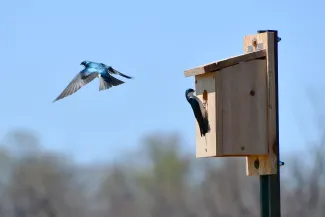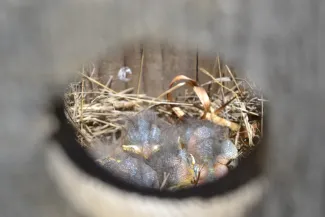
Tree swallows readily accept supplemental nest boxes at Red Slough Wildlife Management Area.
Lack of suitable nest sites often prevents wildlife – primarily birds – from utilizing otherwise good habitat. This is especially the case in many urban areas where natural tree cavities have been removed. In some instances, artificial cavities are especially useful in reducing competition by European starlings. Natural cavities may have entrance sizes large enough to allow access by these pests, but nest boxes can be tailored for specific songbirds by using smaller entrance holes. Also, an artificial nesting structure may provide a more secure site than a natural cavity. These structures can be built to deter predators, parasites, and destruction by winds, storms, and floods.
Tips for Successful Nest Boxes
- Monitor your nest boxes weekly to ensure that undesirable bird species – European starlings and house sparrows – and nest parasites are not present. If they are, take steps to rid the house of their presence.
- Clean the nest box about seven to 10 days after each nesting season to provide a fresh, clean home for birds.
- Repair damage to the nest box. If the box leaks, or if it allows predators to gain access, fix the damage, or replace the house with a new one.
- Remove vegetation from beneath nest boxes to discourage predators.
- Do not put up nest boxes without installing some form of predator guard.
Providing nest boxes in your yard affords a myriad of benefits. Besides aiding local bird populations, you can see all of the bird’s life stages. About 30 species of cavity-nesting birds are found in the Southern Great Plains and can be enticed to some type of bird house. It is important to realize however, that many birds including most cavity-nesters are strongly territorial. One pair will not tolerate another pair nesting nearby. Colonial cavity-nesters such as purple martins are the exception to this rule. For most yards less than a quarter-acre in size, three or four birdhouses is the maximum number that will receive use.
A good nest box should be made of rough wood and should have a roof over all sections to protect adults and young. Small holes are especially important for drainage and ventilation. Houses should be built for a particular species, using the proper cavity size, depth, and entrance hole diameter.
Different species of birds need houses constructed to suite their particular needs.

Most next boxes are based on the simple bluebird house style, although differing in floor size, cavity depth, and entry hole height and diameter.
The Cornell Lab of Ornithology’s NestWatch has downloadable construction plans for various cavity-nesting bird species.
Chickadees, titmice and nuthatches: These birds seem to prefer rustic homes built to simulate natural abodes. Old orchards and woodland borders are good places for their houses. Chickadees often nest within a few feet of the ground, but nuthatches and titmice prefer higher elevation.
Robins and phoebes: These birds will use nest shelves when natural nesting sites are unavailable. The shelves should be placed in partial shade along main branches of trees or under the eaves of a shed or porch roof.
Swallows: Water near the box will help entice these birds to artificial nests. Open or partially covered nest shelves are best for barn swallows, especially if placed under the sheltering eaves of buildings. Cliff swallows should be provided a narrow shelf under an overhanging roof where they can construct their mud nests.
Wrens: Wrens find almost any sort of cavity good enough to suit their needs. Boxes of small size with horizontal slots for entrance are best. The slot opening permits this small bird to carry cumbersome nesting material more readily. Any partially sunlit spot agrees with wrens. A supply of small twigs about three inches long will aid in nest building. It may be best to place several houses in the immediate vicinity, for wrens often build several nests before completing one to its liking.
Purple Martins: The gregarious nesting habits of martins will allow the builder to employ skill and imagination in construction. Important factors to consider are coolness and accessibility. A multi-storied apartment house will attract a colony of martins. The availability of water will be a factor in enticing the birds to nest. The houses should be situated in an open space and painted white to reflect heat.
Bluebirds: Any type of house with the proper dimensions will suit this birdwatcher's favorite. Orchards and woodland edges are the best location for bluebird houses. The house should be placed four to five feet above the ground.
Flickers: Flickers and other woodpeckers do not construct a formal nest the way that songbirds do. Instead, they lay their eggs on a platform of woodchips at the bottom of the nesting cavity. A rough interior is favored by these birds. A quantity of sawdust, ground cork or small chips should cover the bottom so the birds can shape a nest for eggs. Boxes should be placed above immediately surrounding foliage. A dead snag makes an excellent support for their boxes.
- Nest Box Dimensions
Floor (in)
Depth (in)
Entrance Above Floor (in)
Entrance Diameter (in)
Height Above Ground (ft)
Eastern Bluebird 5X5
8
6
1 1/2
5-10
Carolina Chickadee 4X4
8-10
6-8
1 1/8
6-15
Tufted Titmouse 4X4
8-10
6-8
1 1/4
6-15
White-breasted Nuthatch 4X4
8-10
6-8
1 1/4
12-20
Bewick's Wren 4X4
6-8
4-6
1 1/4
6-10
Carolina Wren 4X4
6-8
4-6
1 1/2
6-10
Purple Martin 6X6
6
2
2 1/2
10-30
Great Crested Flycatcher 6X6
8-10
6-8
2
8-20
Northern Flicker 7X7
16-18
14-16
2 1/2
6-20
Red-headed Woodpecker 6X6
9-12
9-12
2
12-20
Downy Woodpecker 4X4
9-12
6-8
1 1/4
6-20
American Robin 6X8
8
At least one side open
6-15
Barn Swallow 6X6
6
At least one side open
8-12
Eastern Phoebe 6X6
6
At least one side open
8-12
Eastern Screech-Owl 8X8
12-15
9-12
3
10-30
Wood Duck 12X12
10-24
12-16
4
4-20
Nest Box Basics
To build nest boxes, begin with the correct materials. Nest boxes should be made from ¾-inch rough cedar, exterior grade plywood, pine, or redwood. Rough-textured wood blends into the natural habitat and aids young birds in climbing out of the nest. As a rule, stay away from plastic and metal boxes, except for commercially made purple martin houses, because these may get too hot in the summer.
Nest boxes should be constructed to keep adults, young, and eggs as dry as possible. To prevent water dripping into the box, extend the roof at least one to three inches beyond the front of the nest box. Providing for interior drainage is very important. Either cut the corners off the floor of the box or drill 3/8-inch drainage holes in the floor near each corner.
Extremely hot summer conditions can be a big problem for nesting birds. Natural cavities usually have large enough openings for ventilation to not be a problem. However, artificial structures need to be modified to keep birds cool. This can be accomplished by drilling several vent holes near the top of the sides or by dropping the front or sides of the box down from the roof a quarter of an inch. Do not use milk carton or cardboard nest boxes – they are not adequately insulated against hot weather and provide no protection from predators.
Nest boxes should be monitored weekly, particularly in urban areas, to note any problems with nest parasites or losses from predators and to remove intruding house sparrow and starling nests. Keeping records will help in managing birds and recognizing problems. Only by persistent harassment can these pests be eliminated. Sparrows can be discouraged by eliminating a perch from the house design and by placing the house a little closer (less than 5 feet) to the ground. Commercial live traps are available which allow you to remove the sparrows and release desirable birds unharmed. Starlings usually will not inhabit boxes within 10 feet of the ground. But remember, any relaxation of the war against starlings and sparrows will find them reestablished.
Birds will not use a nest box that houses wasps. To discourage wasps from using the nest box, coat the inside of the roof completely with Vaseline. The Vaseline will prohibit the wasps from constructing their hanging nests. Although a small nest of wasps will keep birds out, small numbers of mites, lice, and flies that naturally occur in bird nests are not dangerous. However, larger numbers may cause bird deaths. If you find such a problem, sprinkle half a teaspoon of diatomaceous earth or powdered sulfur in the bird house, no more than twice a season. Do not apply these directly to eggs or young.
Boxes should be checked in February and March to prepare for the upcoming nesting season. Mice and other small animals sometimes take refuge in these ready-made shelters during the cold winter months. After each nesting cycle, old nesting material should be removed to keep parasites from reproducing.
Importance of Predator Guards
Although putting up a nest box provides a good home for birds, it can also make them an easy meal for predators such as cats, raccoons, and snakes. To protect birds from these predators, various predator guards are available or can be built. The most effective predator guards appear to be either pole wrappings or circular baffles placed around the pole holding the bird house.
To install pole wrapping predator guards, after placing a nest box on a pole, clear the vegetation from the pole base. Wrap a 2-foot (or longer) section of either 4-inch PVC pipe or sheet metal around the mounting pole and just beneath the nest box to deter leaping predators such as cats and raccoons. Another way to prevent access by snakes or other climbing predators is to use a cone of smooth metal or plastic that umbrellas downward away from the pole. These baffles, which should be at least 40 inches wide, will foil most predators.
This content has been adapted from the Wildlife Department’s “Landscaping for Wildlife” guide. The full guide can be viewed here.